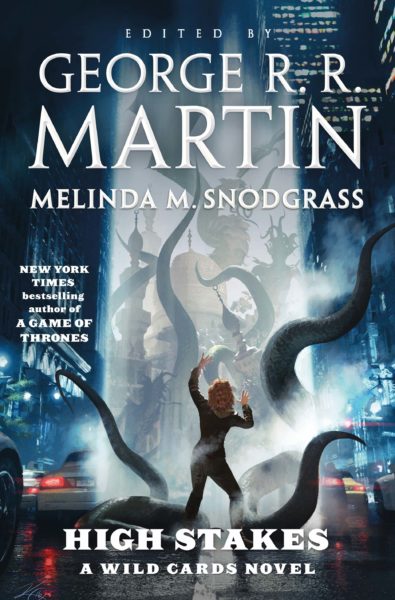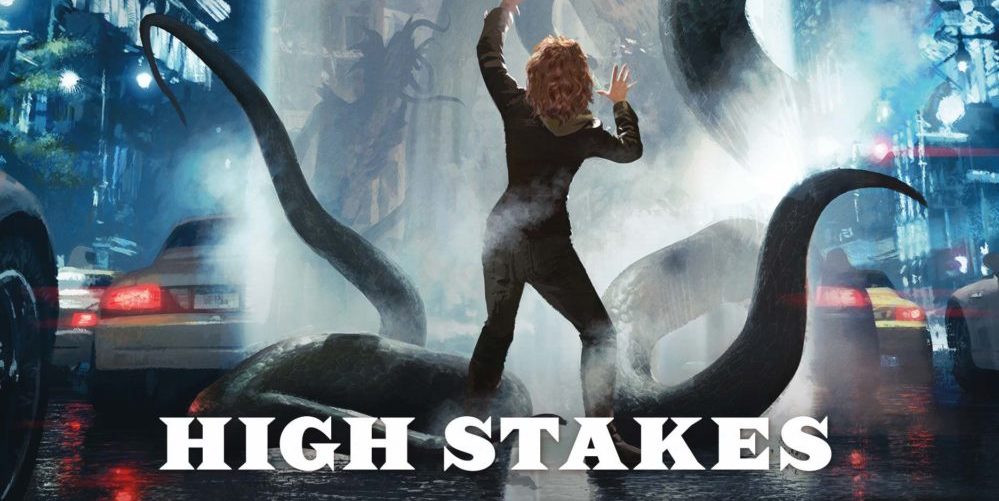
I have two disclaimers on this one:
- I received a free copy, etc., standard, you know the drill.
- I have not read all of the Wild Card books. I have only read High Stakes and its immediate predecessor Lowball (both of which Laura at Tor/Forge was kind enough to send along). The good news is I (think I) got the gist of the history adequately enough to understand the main story beats, highlights, and the important bits of history. Downside: there’s definitely possibility I misconstrued and/or missed some nuance. If that is the case, I apologize in advance and please let me know in the comments.
The Backstory: The shared Wild Cards world, which consists of mosaic novels, short story anthologies, and solo novels, evolved from a gaming group George R.R Martin ran in the early ’80s. Their game of choice was Superworld: the Super Powered Role Playing Game within the confines of which Martin and his compatriots created the shared history of an alien virus which altered human DNA, killing 90% of those exposed; transforming 1% into “Aces” with paranormal powers; and afflicting 9% with “Joker” mutations/malformations. Many of the group’s participants were writers as well as gamers and, in developing characters for the RPG, laid the foundations for the collaborative universe their characters would come to inhabit over the course of the next three decades and continue to inhabit now. To date, around thirty writers have participated in crafting the Wild Cards works. Martin and Melissa Snodgrass are the primary editors.
The two books I read are the most recently published (November 2015 and August 2016 respectively) and make only brief mention of the aliens who brought the Wild Card virus to earth. Quite frankly, I didn’t need the aliens. This sprawling world is packed to bursting with fascinating characters, nuanced social interactions, love, science, magic, a monster fight club, apocalypses staved off and more to come… and that all in the 900 or so pages of which I partook. I need action and character focus to be truly immersed in a novel; the former was frequent enough to be engaging but well spaced enough to allow tension to build. The latter was phenomenally well done, all within the context and framework of the larger story (definitely show rather than tell); I felt engaged with each denizen of the wold, be they unaltered, Ace, or Joker because each and every one of them, while essentially infinitely varied, was also so. Very. Human. Each is multi-layered, multi-faceted, and composed of the perfect amount of each ingredient to suit the whole. I did, of course, have some favorites: The Infamous Black Tongue, Baba Yaga, and Franny.
If you want to know more about them, you’re going to have to do some reading, my friends; I’m not going to spoil the moments of discovery for you.
I’ve read some shared worlds novels in the past, and plenty of themed anthologies, but the concept of the mosaic novel, which is a sort of combination of the two while also very much its own entity, isn’t something I’d encountered in large enough volume to really explore. As a writer who’s attempted some collaborations in the past, I can see how such a project could go very awry very quickly if folks aren’t on the same page or if there’s some sort of misunderstanding or if someone feels their part is more important than anyone else’s. On the editorial end, I imagine someone less experienced or who hasn’t thought the thing through properly and thoroughly might end up under a pile of literal or figurative paper trying desperately to sort it all out and link it all together in a way that makes some sort of sense. Wild Cards has… well, zero of these problems. They chapters fit together seamlessly and it’s obvious from references to shared history everyone is intimately familiar with one another’s work, that they’re all entirely comfortable with being a bead in the necklace or a LEGO in the castle, that they have a collective vision that unifies all the bits even if those bits never encounter one another directly. Though I’ll have to do additional research (AKA, hit the library and the bookstore) to say for sure, my gut, and the friends I talked to who have read the whole series, tell me Wild Cards is the best of what the mosaic novel concept has to offer and has been since its inception.
I don’t think anyone can question the credentials of the editors.

I enjoyed the plot of both books though there are a couple of things that make me partial to Lowball over High Stakes. The first is the organizational structure because, for real, you have to break these things down somehow. Lowball is divided by character; when the narrative point of view shifts, a new chapter begins from the new perspective. While that meant having to keep track of chronology to some extent, in order to figure which events were happening simultaneously, it helped keep the story intact and moving through location, time, and voice shifts. High Stakes, by contrast, is organized into seven massive chapters (Monday through Sunday) necessitating point of view switches within the narrative that occasionally knocked me out of the story or forced me to go back and reread and reset. There were even a few times the voice slipped mid-scene which, to my reader brain, feels akin to being slapped in the face.
The other reason I found myself more attached to Lowball is purely a matter of personal preference: High Stakes dealt more the international body of Aces known as “The Committee,” sometimes leaving the street-level Jokers and non-altereds adrift for a lot of words and a lot of action. I am an unabashed street-level hero loving girl. Iron Man and Captain America are all well and good, but if I I was forced to choose, I’d choose Daredevil, Luke Cage, and Jessica Jones. I like to see my heroes get dirty and screw up and learn, grow. To me, the high level stuff feels almost… not unimportant, but somehow secondary in comparison and I found myself missing IBT, Franny, and some of the others while the fancy folks bickered about who was going where and when they were going. Lowball was almost exclusively street level which and while they were equally well plotted and written, just caught and held my fancy a little more emphatically.
That said, I have every intention of reading more of the Wild Cards volumes as they’re published and am hoping, at some point, to have an opportunity to go back and read all that came before (“hoping” being the operative). I actually have the first entry in the series waiting on my desk for an opportune moment, given to me by a friend who couldn’t believe I hadn’t heard of the series and who happened to have an extra copy. It has an absolutely spectacular ’80s cover and I am sure there are mullets and shoulder pads to be found within. This same friend told me to tell my husband, Jon, who has nerd rage about the length of time between Game of Thrones books, that Luke’s nerd rage takes precedence because every time Martin shifts his focus to GoT, Luke has to wait longer for a new Wild Cards book.
If, like me, you’re new to the series and don’t have the time or inclination to start from the beginning (High Stakes is Book 23 and yes, ’80s and early-’90s sci-fi/fantasy are very special animals with which not everyone gets along), Lowball is a good point to cannonball in: enough mention of the past to fill you in but not so much it bogs you down and enough to make new readers feel included. Keep in mind that different parts of the series have been birthed by different publishers, which may make some volumes more difficult to locate than others. That’s what libraries and used bookstores are for, people.
Lowball and High Stakes, edited by George R.R. Martin and Melinda M. Snodgrass (both published by Tor/Forge), are both available now.


